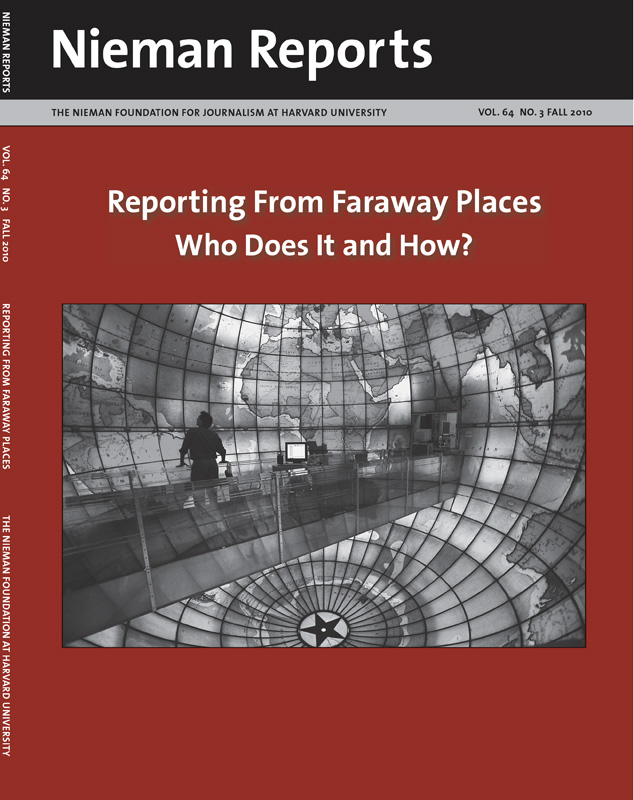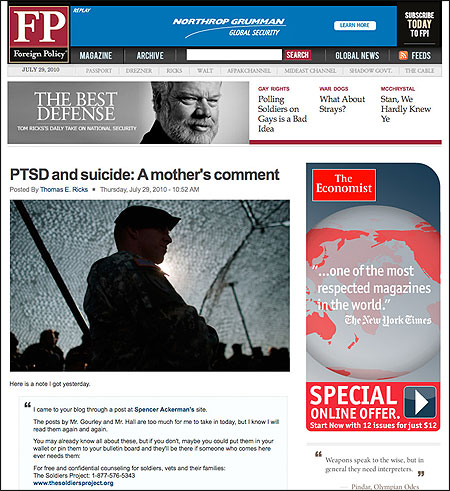
Against this skeptical backdrop, Foreign Policy launched an experiment in January 2009: a new daily online magazine for people who care about the world. Since then our site has attracted a growing audience for original reporting, writing and analysis about global issues—much of which has little to do with either the United States or terrorism. And despite Bollinger’s concerns, we’ve found the Web has also unleashed an abundant new supply of international coverage, making it easy for us to connect with correspondents in Azerbaijan and Burundi, Congo and Colombia, Afghanistan and Pakistan, China and Russia, Egypt and Israel. On any given day Foreign Policy now publishes more original writing about international affairs than The Washington Post or Newsweek.
But Bollinger is right about this: Other sources of foreign news have been cut back or vanished at an alarming rate. The question for journalists, though, is no longer whether we can hold on to the old model of international coverage but whether we embrace new models that work for the digital era. Such models are already out there, as the many vibrant Web sites offering news and commentary about everything from sports to U.S. politics to Hollywood attest. It’s true that foreign news in the future may be more of a niche journalistic product than it was in the past. Then again, the world is a pretty big niche.
Transitional Times
At the start of the decade, I was a foreign correspondent for The Washington Post. When I covered the battle of Tora Bora after the 9/11 attacks, I traveled to that remote part of Afghanistan with a reporter and photographer from The Boston Globe. When the U.S. invaded Iraq two years later, we rode across the sandy border in a fleet of rental cars with colleagues from Newsday and the Chicago Tribune. None of those venerable news organizations has a single foreign correspondent anymore and even The Post, where I was among nearly 30 correspondents just a few years ago, now only has 15 staff correspondents covering foreign news. And it’s not just cutbacks: It has become increasingly clear that the old style of foreign correspondence will have to change, and radically so. With little print space devoted to international news and little to nothing in the way of original Web features, correspondents in recent years have often had to beg their paper or magazine to run their stories, and they have been writing fewer of them.
Instead of reinventing international coverage for the digital era, many news organizations embraced the conventional wisdom—that reader interest wouldn’t be there so it was not worth pursuing—and a self-fulfilling cycle ensued. Foreign news was de-emphasized, kept on the Web long after the news cycle had moved on, or offered little of added value beyond the news wires’ much faster versions, so it not surprisingly received few page views. All of this was taken as confirmation that there just wasn’t any appetite for foreign news.
Like many other pronouncements being made by those in the news business in their panic about the Internet, this claim seemed spurious. Remember these other dictates? Long stories don’t work on the Web. No one reads investigative stories. There’s no value in original reporting anymore; the Web is all about aggregating others’ content. And, my personal favorite: Good design just isn’t important on the Web.
All seemed assumptions worth disproving.
And we set out to do so as soon as the Post Company bought Foreign Policy in late 2008 with the idea of developing a robust Web site to go along with the award-winning but money-losing print magazine. There were some great models to emulate, such as The Atlantic’s savvy collection of newsy blogs and the edgy writing on our new sister publication Slate. Still, the Web seemed like a wasteland in the realm of international affairs, which was often covered as though a small handful of men in gray suits really did run the world—and would be the only ones interested in reading about it. Jokingly at first, but later less so, we decided that our slogan should be “The world is not a boring place.”
Many editors have talked in recent years about wanting to capture the audience and energy of the British newsweekly The Economist, with its impressive print circulation. Most of them look to emulate its opinionated and sharp analysis, not necessarily its single-minded gaze on the world. For us, the appeal was in fact the international outlook at a time when more people than ever perceive themselves as global stakeholders. We wanted to combine a relentless focus on the world with the belief that a dedicated, underserved—and large (or at least large enough) community of readers was out there.

Thomas E. Ricks, formerly a reporter for The Washington Post, blogs daily for Foreign Policy about national security.
Launching Our New Site
At the start of our Web relaunch, here’s what we had: essentially no money, no reporters, a creaky and often barely functioning custom-made Web platform, a wonderfully talented young staff—and the freedom to try new things with the edge and sensibility that a traditional news organization would find hard to get away with. At the time Foreign Policy had exactly one blog and published a single Web-exclusive article every day or so. Our site averaged just fewer than one million page views a month.
In six weeks we created a new site—with a new approach to covering foreign news. We constructed it around a vibrant homepage and created a network of blogs written by authoritative experts, including Pulitzer-winning military reporter Thomas E. Ricks on national security, Harvard’s Kennedy School professor Stephen Walt on international relations, and former Clinton administration official David Rothkopf on how Washington actually works. We also recruited established independent bloggers, including international trade expert Daniel W. Drezner and Middle East scholar Marc Lynch, who signed up after learning of the project from Drezner’s Facebook update. For the first time in Foreign Policy’s 40-year history, we added original reporting, with The Cable, a daily blog reporting on the Obama administration’s foreign policy team and its initiatives; by scooping more established competitors about who was getting what job, it became a must-read in Washington.
Soon after we relaunched our audience tripled, and it has continued to expand. As of this summer, it had grown 1,000 percent to more than 1.5 million unique visitors and 11 million page views a month. We now publish more than 100 original articles each month—an average of five or more every weekday as well as the daily blogs. On any given day the site offers a mix of stories: a scoop about the United Nations looking to award a prize endowed by an African dictator; an essay by Turkey’s influential minister of foreign affairs; former top Bush administration officials politely castigating the White House in their Shadow Government group blog; a sharp dispatch from Moscow; an op-ed salvo from Senator John Kerry; the latest installment of journalist Anna Badkhen’s monthlong journey across northern Afghanistan; a report about Israel’s settlements on our new Middle East Channel.
Our approach to telling these stories ranges from first-person narratives to short items about State Department scuttlebutt, from policy debates to slideshows. At its core, what we are doing on the Web is a natural digital evolution of a magazine’s roving curiosity about its subject—with far more entry points and daily variety than was possible before, when editors had to make painful choices about which small handful of foreign pieces they would run.
In that and so many ways, we’ve been lucky. As counterintuitive as it might seem, this is a great time to create new pathways for journalism—and journalists. There is no shortage of writers with a real desire to connect with the audiences we reach—and fewer and fewer ambitious places to feature their work. Given the exodus from many news organizations of journalists forced into painful transitions, now is a good moment to go looking for expertise.
Ricks was our first such recruit. The author of the bestselling book “Fiasco: The American Military Adventure in Iraq” and a veteran of The Post, he had taken a buyout from the Post to become a senior fellow at the Center for a New American Security. Now his daily blog The Best Defense is defining a new genre of reporting. With several original items a day, his blog features everything from e-mailed comments from General David Petraeus to investigative reports on the military’s cover-up of a disastrous battle at the Afghan outpost of Wanat (later covered on the front pages of the Post and The New York Times). In the spring Ricks was recognized with the first National Magazine Award for best blogger of the year.
But Ricks also suggests the limits of our new approach; for now, Foreign Policy’s new Web site couldn’t exist without the support of institutions—whether universities or think tanks or more deep-pocketed mainstream news organizations—that still pay some of those who write for us something approximating a living wage. Only a few of our writers are full-time Foreign Policy staffers on the old journalism model; indeed, most of our staff is an editing staff, working to pull together a coherent site from an array of contributors who run the gamut from young freelancers abroad to leading experts in their fields looking to reach our audience. For some, this is a replacement for the newspaper op-eds they used to write and little payment is expected, then or now. But for others, the time will come when someone will have to pay more to sustain the independent journalism they are doing. Until we have the money to do so, we are intent on experimenting with any model that works, from the New America Foundation fellow who works with us as a contributing editor to the Carnegie Corporation grant that helps support the scholars who collaborate on our Middle East Channel.
Experiment is the key word. The Web certainly made it easy and inexpensive to find and grow our audience; it has also connected us to a network of new writers and readers in countries throughout the world. Advertising has grown, too. But beware of anyone who claims to have cracked the code; I’m not sure there’s any business out there that can credibly argue it’s figured out what it takes to support the journalistic ambitions of a magazine determined to take full advantage of the digital era. Until then, an experiment it will remain.
Susan B. Glasser is editor in chief of Foreign Policy magazine.


